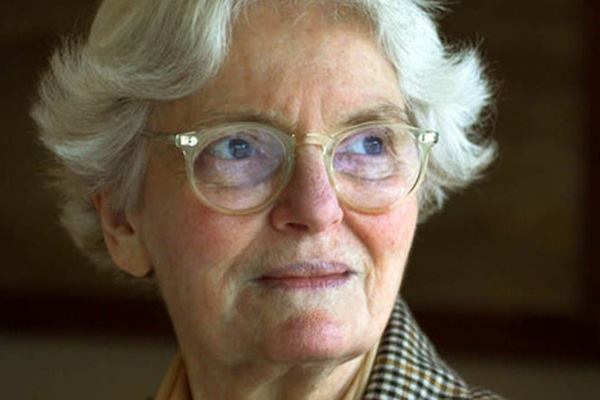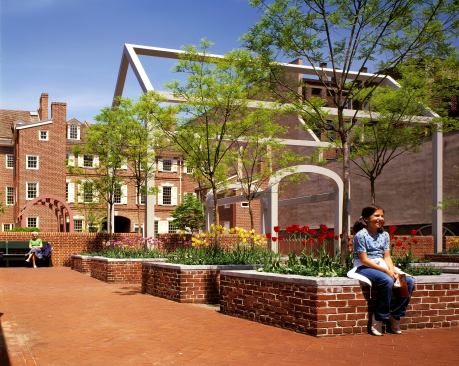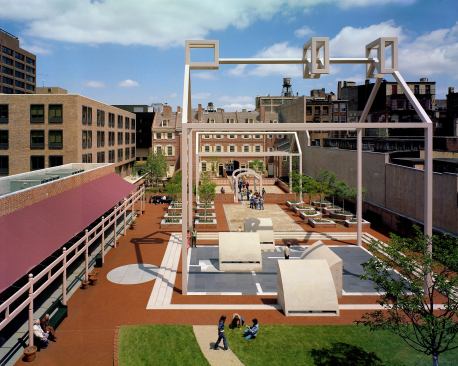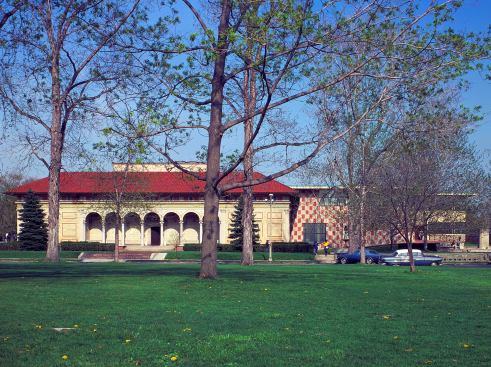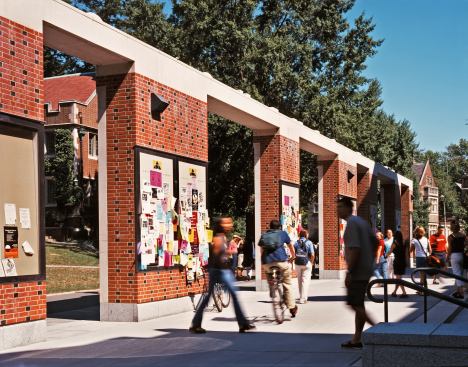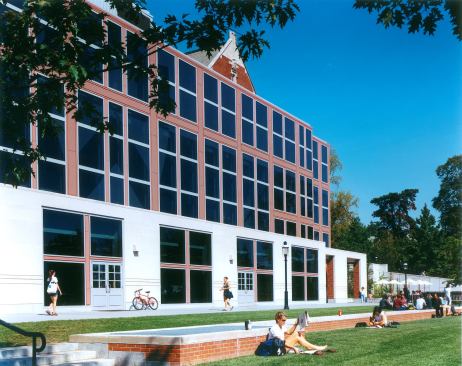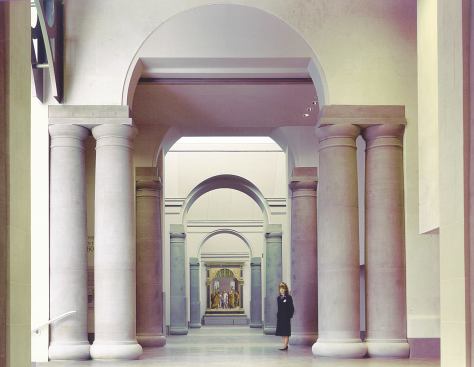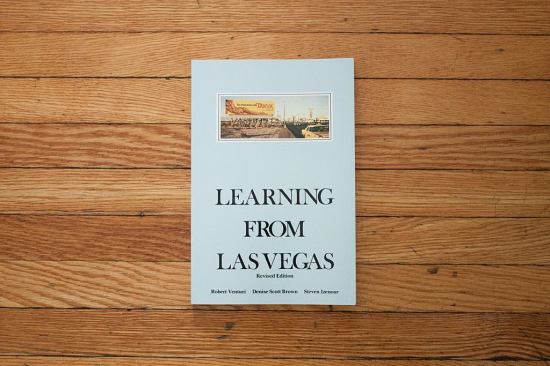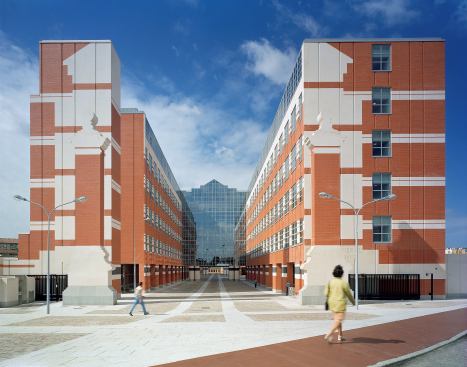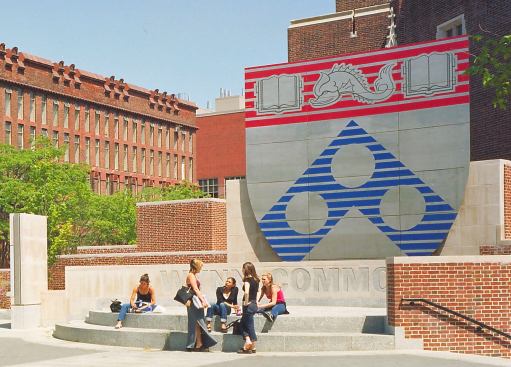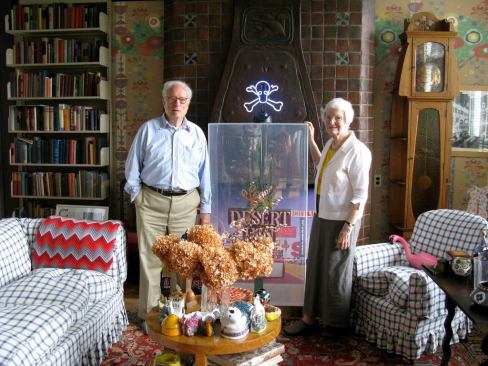Courtesy Mark Cohn | Venturi, Scott Brown and Associates, Inc.
Franklin Court, 1976, Independence National Historical Park, Phi…
More Coverage of Denise Scott Brown

Pritzker Architecture Prize Committee Refuses to Honor Denise Scott Brown

Pritzker Prize Jurors Decline to Discuss Denise Scott Brown at Ceremony

Architect Interview With Denise Scott Brown

Media Ratchets Up the Pressure on Pritzker Prize Jury

Reconstruction and Symbiosis: Fixing Past Mistakes

Pritzker Architecture Prize Committee Mulls Petition for Denise Scott Brown
When Philadelphia architect Robert Venturi, FAIA, received the Pritzker Architecture Prize in 1991, the award generated a good deal of grumbling from many in the architectural community for the person who wasn’t named: his wife and architectural partner of roughly three decades, Denise Scott Brown, FAIA. Venturi and Scott Brown met in 1960, married in 1967, and became architectural partners in 1969. They collaborated on buildings and books—including the widely influential (and controversial) urban study, Learning From Las Vegas, published in 1972. The fact that Scott Brown wasn’t also named a Pritzker recipient has been variously described as an “injustice” and a “blunder” by the architectural press. In March, the debate was reignited when Scott Brown was quoted by the Architects’ Journal as saying, “They owe me not a Pritzker Prize but a Pritzker inclusion ceremony.”
That statement ignited a flurry of debate—and inspired the Harvard University Graduate School of Design Women in Design Group to launch a petition demanding that the Pritzker Prize committee recognize Scott Brown’s contributions to the field of architecture. As of this writing, the petition contains more than 4,000 signatures, including those of architect Zaha Hadid, Hon. FAIA; Rem Koolhaas, Hon. FAIA; and Museum of Modern Art design curator Paola Antonelli. Plus Venturi himself. (In a short note attached to his signature on the petition, Venturi wrote: “Denise Scott Brown is my inspiring and equal partner.”)
Scott Brown told ARCHITECT that the attention has been “like a tidal wave.” She says that she never imagined that the comments that she gave for the Journal‘s women’s architecture luncheon would generate so many headlines. Earlier this week, she took time to talk with ARCHITECT about the Pritzker, her role in the firm she ran with her husband, and the ways she has been treated as a woman architect in a profession that she has described as a “19th-century upper-middle-class men’s club.”
Why raise the issue of the Pritzker at the Architects’ Journal luncheon?
DSB: They asked me on camera about it as part of this video they were making. They had called me and said will you please come and talk at this luncheon we’re giving. I said, “I’m going to Mexico City, I can’t be in both places at once.” So they said, well, will you make a video? When they asked me about the Pritzker Prize, I just told them what the story was. So they played the video and then they ballyhooed it in the Architects’ Journal.
As a result of that story, a group of women graduate students at Harvard launched a petition asking that the Pritzker committee recognize your work. What is Mr. Venturi’s opinion of all this? Didn’t he recently sign the petition?
He signed the petition, yes. Read what he wrote. Bob believes—how does he put it: “Excuse nothing. Explain nothing.” So he wanted to put something that represents his feelings and didn’t excuse and explain. I think he did something very cool and very nice. It’s also hard for him. It’s hard on many levels. By the way, they said he is unwell. He isn’t unwell, he is just old. He doesn’t really want to be involved in architecture very much—or in this quarrel.
During an interview at Drexel University in 2008, you said of the Pritzker committee: “It took 23 years for them to find a woman [2004 Pritzker Prize winner Zaha Hadid] who fits the mold that, to them, means great architecture. Now I criticize their criteria enormously. But the fact that they couldn’t bend their criteria—they couldn’t see other ways of being an architect. They couldn’t say, ‘Maybe there are various streams.’” In your mind, what are the various ways of being an architect?
There’s a million ways to be a woman. There’s a million ways to be a mother. And there’s a million ways to be an architect. There’s a book that came out recently where they go into four different projects run by four different architecture firms—and they show how they’re differently organized. In some cases, one designer is the complete boss and everyone else is kind of a peon. In others, consensual design goes all the way and it’s very difficult to tell who did what. And there’s a range in between. Within our office, there was a range, too.
The issue of being overlooked professionally is something you address in your 1989 essay “Room at the Top? Sexism and the Star System in Architecture.” In it, you write, “I watched as [Bob] was manufactured into an architectural guru before my eyes and, to some extent, on the basis of our joint work and the work of our firm.”
My ideas went where I couldn’t go, you could say. My ideas were credited, but they were credited to Bob. Nancy Trainer describes how she was the project manager at a meeting we had with a client’s group where we were talking with the board about a stadium and it had to have six seats added to it all around. I had an idea about how to do it, and I whispered something to Bob about it. And he said, “Yes, I agree with you. It’s a good idea.” Then I said the idea to the client. Bob had not said anything, but by the end of the meeting, they were referring to it as Bob’s idea.
You wrote “Room at the Top” in the 1970s, yet it wasn’t published until the late 1980s. What inspired you to write it? And then to hold back on its publication?
I wrote it because I was very angry. I’d been an associate professor at UCLA. I’d been with powerful people. At Penn, I was a colleague of [architects and urban planners like] Holmes Perkins, Bob Mitchell, William Wheaton—people like that. I thought the mantle of power covered me, too—and had I been a man, it probably would have. But all of a sudden, I am told things like, “This is Bob’s writing, he is just using your name.” Or: “Would the ladies please move out of the picture so we can have the architects?” I would say, “I am an architect.” And they’d say, “Would you move out of the picture, please?” So I started putting down experiences that I’d been having. But that was when the first real bad news came out about how angry I was making some people. I began thinking, “This could be really bad for Bob and also for our office.”
What happened when you spoke openly about being left out?
[Architectural historian] Colin Rowe got furious with me. He once said to me, “Denise, you must admit that I was Mr. Mannerist of the 1950s.” He felt that Bob was taking his role. I said to Colin, “If you are criticizing Bob, you should be criticizing me, because we both did this stuff.” He looked at me totally unbelievingly. Then, at a party, he put his arms around me holding his whiskey glass, spilling his whiskey down the back of my neck, and said, “Denise, cara mia. Fuck you, bitch!”
There was another time when Frederic Schwartz, who worked in our office, was at a presentation where they presented the Miami Beach project. The architects there were all praising it, saying, “This is a wonderful project that Bob has done.” So, Frederic, who worked with me on it, said, “You know, Denise did it.” The guy who was there — I guess he was one of the bigwigs in New York — he got so furious, he walked off the stage. But, he didn’t walk out of the correct door, he walked into a closet and had to come walking back again!
A lot of the men were very angry. Another angry New Yorker was Philip Johnson.
How so?
Philip Johnson used to say, “We’re all going to go to the Century Club—the architects, but not their wives. And we’re going to wear evening dress and we’re going to talk about architecture.” So they invited Bob. The person who called said to me, “I’m embarrassed to have reached you, Denise, I wanted Bob. You can’t come to this meeting because you’re a wife.”
That’s an anecdote you included in your essay — except you keep Johnson anonymous, referring to him simply as “QP.”
In the afterword to my book [Having Words], I expose for the first time that the person I called QP in that article was Philip Johnson. Someone invented some weird thing that said QP stood for such and such. It didn’t. I called him QP because in looks he reminds me of a Kewpie doll. You have to get your revenge somehow!
In light of the issues with the Pritzker, I want to better understand your collaboration with Mr. Venturi. In many articles, he is listed as the designer and you as the planner. Is that description accurate? It’s very, very difficult to define us. I’d say that Bob is a very focused person who is surprisingly broad. And I’m a very broad person who is surprisingly focused. Bob is one of the few architects who I feel has a real understanding for urban design.
Do you design the buildings together?
We sure do. The process of joint creativity, which is what I like to call it, is: One has an idea, the other sees its relevance. The other then produces something and the first says, I could add to it this way. In some of those very large projects, I have initiated the parti program—for example, the Provincial Capitol Building in Toulouse, France. This is an old historic city, with quite small houses and a medieval city plan. The site had streets on two sides, a canal on one side, and an artery on the other. I saw that there was a little shopping center right next to the canal, and on the other side there was this other shopping center. You could draw a diagonal and link these two shopping centers—a pedestrian shortcut through the site. If we make the buildings on the two sides of that diagonal, we can make them lower than if we made just one big slab. The area around it is very modest and we don’t want it to be over-scaled for what’s around. We built it that way and now people use it that way. Of course, there was so much more in the way of design decisions—and I shared in many of those, too.
Naturally, there were some projects that Bob worked on more and others that I worked on more. Sometimes our collaboration was more close than others. But I think our best projects were when we worked together. I remember so many real tousles—and those were the projects that worked out best.
Among other books, you and Mr. Venturi collaborated on Learning From Las Vegas with Steven Izenour—a work that examined the vernacular car-centric architecture and urban planning of the Vegas strip. What were your roles for a project of that nature?
The idea for that book is mine and the methods of teaching the studio [that resulted in the book] are mine. I had not only been once to Las Vegas when I invited Bob, I had been four times. We are all very cognizant of architect-designed places. And then there’s Las Vegas. Everyone’s flocking there. So I said, “Why aren’t we looking at it?” When I first saw the Strip, I was just blown over. It reminded me of Greece. The light was so clear and pure and it reminded me of the fact that the Greek sculptures in Athens had been covered with paint. They weren’t Pentelic marble, they were bright colors. And I looked at the bright colors of the signs against the blue, blue sky and I said, “This must be how ancient Greece looked, so let’s go learn what this is all about.” I wrote the introduction and the bibliographies to the book. But as we got into doing work topics, both Bob and Steve added theirs as well. So they’re not all my work topics. But it was all very collaborative.
You’ve said that the Pritzker and some critics foster a star system that doesn’t get at the cooperative nature of architectural work. Why do you think that is?
Where do we make women stars? Movie stars. Opera divas. In a ballet, the male lead is given more praise than the female wife in an architecture team. Why is that? It’s very hard to tell why in architecture it is different. Something to do with the fact that you can’t define what is good design, and yet architects very livelihood depends on being called a good designer.
The Pritzker is said to be evaluating your case, one that they describe as an “unusual situation.” What is your feeling on how this might turn out?
I’ve talked to [Pritzker executive director] Martha Thorne before about this very issue and she’s said the very thing she’s saying now: It is a jury and the jury makes the decision. This is a time when they must make some policy decisions. They have to think through where their values are. I’ve said to her, “I’d really much rather talk with someone in the Pritzker family than talk with the jury.”
Women who make demands are often cast as the shrew. How do you feel about that?
Well, I’m used to being a shrew. What are you going to do? I was in Mexico City recently. It was the launch of my book in Spanish, Having Words. I told the assembled group of people there: “When I was a very young student, I was totally lost. That was part of the reason why I left for England, because I didn’t know what architecture was about. Now it all seems to be very coherent, but that didn’t help me at your age.” After the lecture, one young woman came up and she said, “I feel just as lost as you describe yourself feeling. What should I do about it?” And her boyfriend says, “She was really trying to say…” I said, “Wait a minute. It’s very kind of you to be so concerned about this woman’s problem, but the best thing you can do for her is to let her describe it for herself.” If that’s the beginning of being a shrew, it’s worth being a shrew.
What in your view would be the best outcome for this situation with the Pritzker committee?
My huge reward in life has been that clients of complex projects have trusted me with a design—and then it’s come out the way I intended it to be. There are people all over my open spaces, the coffee shops are, in fact, used, the analysis was right, the design was right, the building is successful. Where that’s happened, I’m very proud. Another big reward now is that 4,000 people have sent a petition and are expressing outrage. That’s a real big reward. That’s real validation—as important, at least, as winning the prize.
